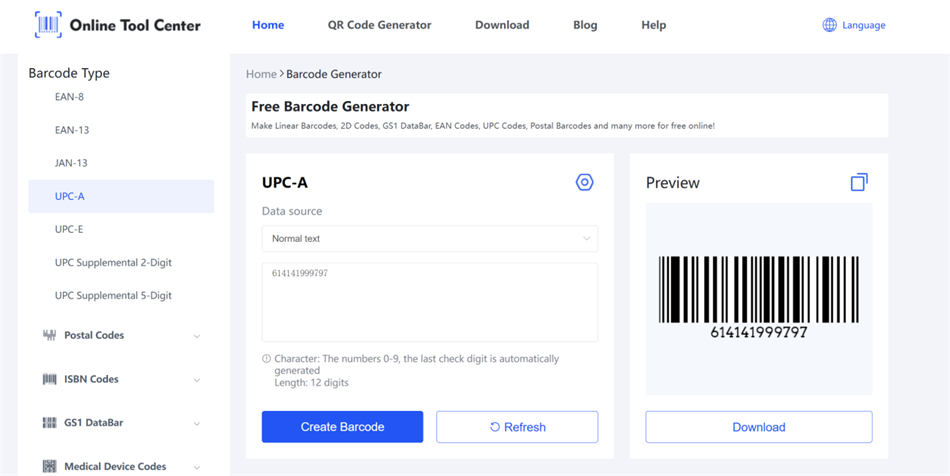Ever wonder how shops keep track of everything? Product barcodes are the secret sauce! They make managing stock so much easier. Checkouts? Way faster. The most common type you'll see, especially if you're in the US or Canada, is the UPC-A barcode. Now, if you're selling products, you'll need to get these barcodes onto your items. That's where a UPC-A barcode generator comes in handy.

Whether you've got a whole catalog of stuff or just a few items heading to the shelves, this guide will walk you through what UPC-A is all about, how to generate a barcode, and the tools that can help you do it.
What is a UPC-A Barcode?


● What Barcode Format is UPC-A?
UPC-A is a linear (1D) barcode format, which means it encodes data using a series of parallel lines (bars) and spaces of varying widths.
Its format is a 12-digit number that cashiers scan to pull up the item's info. You see them on packaged goods everywhere—supermarkets, drugstores, clothing shops, you name it. They're the standard in the U.S. and Canada.
While UPC-A is the most common format, there's also a compressed version called UPC-E, designed for smaller packages where space is limited. Both serve the same purpose, but UPC-E uses fewer digits by eliminating unnecessary zeros.
The 12 digits in a UPC-A code are structured as follows:
Digits 1-6: This is the company's ID number (called a prefix), given out by an organization called GS1. It tells the system who made or owns the product.
Digits 7-11: This part is the specific item's number. The company assigns this to differentiate, say, a blue shirt from a red shirt.
Digit 12: Check digit (automatically calculated to validate the code)
● Where You'll Find Them
UPC-A barcodes are workhorses in places like:
✔️Retail stores (groceries, electronics, clothes—basically anywhere you shop)
✔️Warehouses and shipping centers
✔️Online marketplaces like Amazon, Walmart, etc.
Because they're just numbers, barcode scanners can read them super fast, which is why they're so popular.
Why You Need a UPC-A Barcode Generator
Barcodes don't generate themselves—and manually creating one is not only inefficient, it can lead to formatting errors or compliance issues.
Here's why using a specific UPC-A barcode generator tool is the way to go:
●Accuracy: Ensures your 12-digit code is formatted correctly and the check digit is valid.
●Speed: Quickly produces barcode images ready for printing or packaging.
●Convenience: Many online generators allow you to download images in PNG, JPG, or SVG formats.
●GS1 Compliance: Trusted tools support official formatting standards.
A barcode generator is especially useful for small businesses, Amazon sellers, or manufacturers that need to label products for retail sale without investing in complex software.
How to Generate a UPC-A Barcode (Step-by-Step)
Step 1: Obtain a Valid 12-Digit UPC Code
You can't simply make up a barcode. To sell in retail stores or online marketplaces, you typically need a GS1-assigned UPC number. These numbers are globally recognized and ensure your product information is unique and traceable.
If you're working with resold goods or private label products, you may use UPCs provided by the supplier—just be cautious of non-GS1 codes as some retailers (like Amazon) may reject them.
Step 2: Choose a UPC-A Barcode Generator
There are many options online, both free and paid. A good barcode maker allows you to:
● Input your 12-digit code
● Select barcode symbology (make sure it supports UPC-A)
● Download high-resolution barcode images
Make sure the tool you choose includes a preview to verify your input visually.
Our Online Tool Center is a free online barcode generator, which supports a wide variety of linear and 2D barcode formats, including UPC, EAN, Code 128, QR Code, and GS1 Databar.

Generating a UPC-A barcode with it is simple. There are no confusing steps, just paste your valid 12-digit UPC, click generate, and you'll get a crisp, clear, and perfectly formatted UPC-A barcode image in seconds.

We focus on generating accurate, scannable barcodes that meet industry standards, ready for you to download in various formats such as PNG and SVG, and use right away. It's a hassle-free option perfect for getting your products labeled efficiently, whether you're just starting out or need a dependable tool in your workflow.
Step 3: Enter the Code and Generate the Barcode
Simply paste your 12-digit UPC into the tool, confirm it's correct, and click"Generate." You should see a barcode image appear instantly. This image can be downloaded and printed onto product packaging or labels.
Step 4: Test and Print
Seriously, don't skip this step! Before you go printing labels for your entire inventory, do a quick test:
● Scan the generated barcode image using a barcode scanner app on your phone or an actual scanner if you have one. Does it scan easily? Does it show the correct 12 numbers?
● Make sure when you print it, it's clear and not blurry. The lines need to be sharp for scanners to read them properly.
Common Mistakes to Avoid When Using a UPC-A Barcode Generator
● Using invalid 12-digit numbers
A valid UPC-A must follow GS1 structure and include a correct check digit.
● Wrong symbology
UPC-A is not the same as Code 128 or EAN-13. Make sure you're using the correct format.
● Improper sizing or low resolution
If the barcode is too small or blurry, scanners may fail to read it. Stick to standard print sizes (minimum width: 1.469 inches).
● Duplicating UPCs across different products
Each unique item should have its own UPC code to avoid confusion in inventory systems.
FAQs About UPC-A Barcode Generators
● Can I create a UPC-A barcode for free?
Yes. There are several free tools available online that allow you to generate UPC-A barcodes using a valid 12-digit code.
● What if I don't have a GS1-assigned number?
You can purchase individual UPCs through resellers, but be cautious—some marketplaces only accept GS1-issued codes.
● Is UPC-A the same as EAN-13?
No. UPC-A is 12 digits and used primarily in North America, while EAN-13 is 13 digits and more common internationally.
● Can I reuse a UPC-A code for another product?
No. Reusing codes can cause major issues in inventory systems and is not GS1-compliant.
So, whether you're bringing a brand-new product into the world or maybe just giving your current labels an update, choosing a good barcode generator tool is key. It's how you make sure your barcodes are accurate, scan smoothly first try, and tick all the boxes for the stores and warehouses handling your stuff.
Need to whip up some barcodes fast and easy? Check out our free UPC-A Barcode Generator Tool! Or, if you need help with generating lots of codes, integrating them into your systems, or API solutions, feel free to get in touch!




